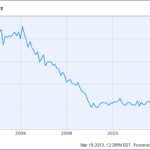The Dogs of the Dow strategy might as well be an initiation to the stock market. It’s often the first “strategy†that investors run into on their way into the market.
As simple as the Dogs of the Dow strategy is, an ETF based on a variant of this popular investing strategy is beating the market. I think it’s truly one of the best purely quantitative funds in existence, yet investors have yet to put their full faith in the ALPS Dividend ETF (SDOG). AUM stands at a mere $244 million.
What SDOGS does best
The ALPS Dividend Dog ETF (SDOG) selects five of the highest-yielding stocks in each of the 10 sectors of the S&P 500 index (SPY), then equal weights each selection. The result is a very well diversified portfolio of high yielding stocks in a vastly different mix than the S&P 500 index. The S&P 500 underweights some of the highest yielding stocks on the market, holding a few percentage points of utilities and telecommunication stocks.
Here’s the breakdown for the S&P 500:

Naturally, SDOGS diversification leads to very different results. Since inception, the Dividend Dogs ETF has trumped the returns of large cap stocks, even after a recent market rout left dividend stocks in the dust. Utilities recorded one of the worst months in history in May 2013 when the Utilities SPDR (XLU) fell by 8.14%.
Dividend Dogs are up 22.87% in the last half-year and 19.75% year to date vs. a 26 week return of 19.48% and a year to date return of 16.18% for the S&P 500. Returns include dividends.
As far as yields go, SDOGS leads the pack. Dividend Dogs reward investors with a yield of 3.96%, besting SPDR’s S&P Dividend ETF (SDY) at 2.7% and the iShares Dow Jones Select Dividend Index Fund (DVY) at 3.4%. Â (See the following High Yield ETFs for higher yields in different genres).
What makes the fund most interesting is that it rebalances quarterly, locking in profits in rising sectors and adding additional capital to losing sectors. This mechanism makes it perfect during periods where sector investing creates volatility in a particular space. For instance, investors are currently swapping defensive names for cyclical exposure. When the Dividend Dogs ETF rebalances, it can take advantage of more compelling valuations.
Selecting from a universe that includes only the 500 stocks in the S&P 500 index adds to the quality of the 50 underlying investments. A chart from ALPS shows that S&P 500 firms have much more consistent (and favorable) dividend policy than stocks too small for the large cap index.
Risky positions
When investors screen solely on yield, they’re bound to find a list of less than exceptional stocks. A high dividend can come as the result of a  low stock price, or an overly dividend given a company’s future earnings potential. Rebalancing keeps the Dividend Dogs away from holding poor stocks for too long.
A quick look at the fund’s holdings reflects a few unsavory names. Stocks like Best Buy (BBY) and Pitney Bowes (PBI) are certainly dangerous given that their business models are in question. Large scale electronics retail and the sale of postage meters would hardly top a list of top businesses in 2013. The fund has capitalized on the volatility in riskier names. Best Buy is the fund’s top performing stock, lifting the fund with capital gains that are soon to be locked in when it rebalances. Of course, it was a poor performer for the fund through 2012. If the Dividend Dogs fund were rebalanced only annually, performance would likely fail to keep up with the market. Rebalancing quarterly gives this fund a lift during periods of market volatility.
Bottomline: at a cost of .40% of assets each year, the Dividend Dogs fund is one of the best funds for current income, offering higher yields than alternatives atop a very diversified portfolio of 50 stocks. This is the perfect fund for someone who wants current yield from a diversified mix that includes all ten sectors of the S&P 500.











{ 0 comments… add one now }